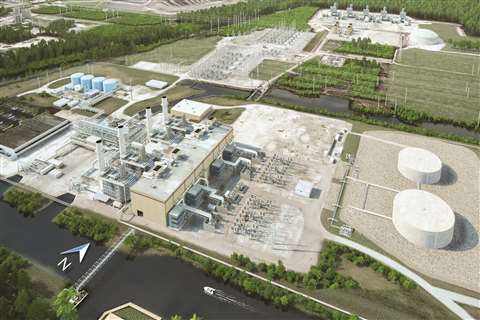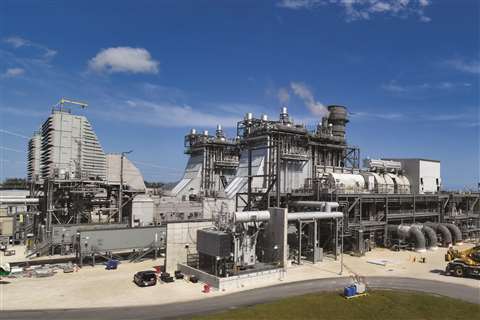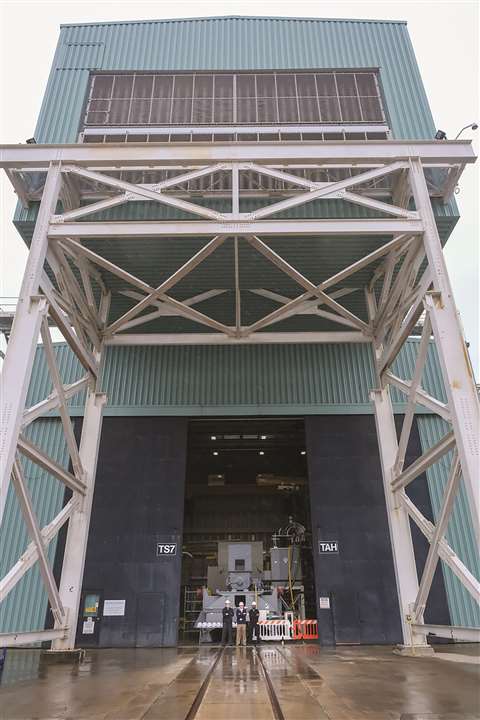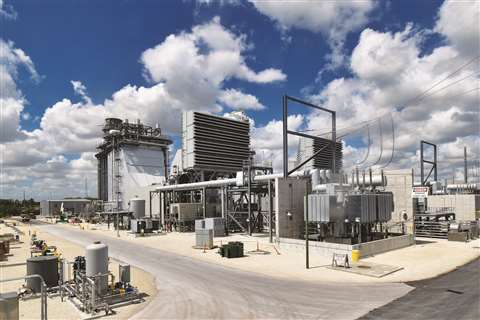World-first gas turbine application at Florida power plant
16 September 2022
GE’s 7HA.03 gas turbines see first commercial operation at the 1260 MW Dania Beach power plant
 The Dania Beach site has produced power since 1927 and was last updated nearly a quarter-century ago. Some of its major components had operated since the 1950s. (Photo: GE Power)
The Dania Beach site has produced power since 1927 and was last updated nearly a quarter-century ago. Some of its major components had operated since the 1950s. (Photo: GE Power)
The Dania Beach power plant, which went into operation in 1927, is providing more power, more efficiently and with fewer emissions than ever before. The Florida Power & Light Co. (FPL) facility near Ft. Lauderdale was able to accomplish all that by switching out four turbines with two GE 7HA.03 gas turbines — the first time the GE 7HA.03s have been in commercial operation.
The Dania Beach project updated generating units that were last updated nearly a quarter-century ago, and some of their major components had operated since the 1950s, according to Christopher Mastriani, GE account executive. The facility is now delivering up to approximately 1260 MW — about 280MW more than before.
FPL said the new modernized facility is expected to produce US$337 million in savings for customers and improve service reliability in Southeast Florida. The new energy center incorporates key components of the existing infrastructure. That means no new offsite power transmission lines, no new natural gas pipeline and no new electric substations were needed. Since the plant went from four gas turbines to two and from two steam turbines to one, it will also achieve about a 70% reduction in primary emissions.
“Where this plant is located is downtown Ft. Lauderdale, there’s not a lot of capability to add new power generation in that area,” Mastriani said. “So, the fact that the existing plant had probably reached its maximum output, and the fact that it was an older 1990s technology plant, it didn’t have a lot of the flexibility that the plant equipment has today in terms of ramp rate, operating window…and these units can be turned down to much lower loads, particularly at night.”
That will become increasingly important for FPL, since it plans to add more and more renewables to its system, Mastriani said.
“Having a plant that’s very flexible, to be able to ramp up quickly, operate across a wide load range, is important for them,” Mastriani said. “And I think those older plants just didn’t have the flexibility or the capability to operate across that regime where you have a lot of renewables now coming into their system.”
Future proofing
Plants like the Dania Beach facility produce around-the-clock power, enabling FPL to continue its rapid solar expansion, which the company said is the largest in the United States. FPL also said that, with some modifications, its natural gas units – like the ones at Dania Beach – may be fueled by hydrogen instead of by natural gas in the future. The use of natural gas as a fuel for these units already results in the lowest carbon emissions possible from fossil fuel use. However, being able to use hydrogen as a fuel would result in zero carbon emissions from the operation of these units. FPL is currently developing a pilot project that will test using green hydrogen to replace a portion of the natural gas at its power plant in Okeechobee County, Florida, which also utilizes GE technology.
“This combustion system is capable of running on 50% hydrogen,” said Chris Corron, a product manager for the 7HA.03 who has been with GE for more than 30 years. “Now, any plant that you want to run a lot of hydrogen, you’ll have to make some updates to the subsystems for that plant. But the gas turbine itself is capable of 50%, which, as you know, there’s just not that much hydrogen available these days in the industry. But we’re confident that with this gas turbine and the combustion system, we’re always going to be ahead of that hydrogen supply. So, the customer, once they buy our machine, can kind of future proof their technology; as hydrogen becomes more economical, becomes more available, the gas turbine is not going to be the constraint on how much hydrogen the customer can burn.”
 The approximately 1260 MW Dania Beach Clean Energy Center in Florida is powered by two of GE’s 7HA.03 gas turbines. The repowering marks the first commercial operation of the 7HA.03 technology. (Photo: GE Power)
The approximately 1260 MW Dania Beach Clean Energy Center in Florida is powered by two of GE’s 7HA.03 gas turbines. The repowering marks the first commercial operation of the 7HA.03 technology. (Photo: GE Power)
This capability to burn hydrogen is enabled by the DLN2.6e combustion system that is standard on the 7HA.03 units installed at Dania Beach. Developments in hydrogen-based power generation mean that gas turbines offer great potential to operate while reducing their carbon intensity and can represent a destination technology, not just a bridging technology.
The 7HA.03 gas turbine achieves a more than 64% net combined-cycle efficiency, 75 MW ramp rate per minute. FPL and GE estimated savings of up to over $330 million over the life of the project.
“I think they viewed the .03 as kind of the starting point,” Mastriani said. “One of the things that FPL likes to do, and has done well historically, is take their existing plants and continue to upgrade them as time goes on. And as the Florida market changes, so does the need for more flexibility and more generation. So, I think they saw the .03 as a machine that they can continue to upgrade and grow with.”
Modular design speeds project
The RFP for the plant and equipment came out in 2017 and tearing down the old plant began in 2019, Mastriani said.
“I do also know that they were very anxious to get this plant back on as soon as possible,” Mastriani said. “They established June 1 (2022) as the COD Day with a pretty aggressive timeline.”
Mastriani said the site faced “typical COVID challenges” with finding workers, especially craft labor. The project also had a fair number of supply chain issues and logistic challenges getting some new equipment from overseas suppliers.
“We did have some equipment and material that did show up late, but I would say with the combination of the TAs on site and the relationship with FPL and Black & Veatch OCI, which was the EPC for the plant, we were to [able to] work around a lot of those logistical challenges,” Mastriani said.
One thing that helped hit COD Day was 7HA.03’s modular construction. Large parts of the plant and its accessory were manufactured and shipped already assembled to the construction site. This included the gas turbine enclosure that houses the machinery, which consists of several pieces, each around the size of a shipping container. This modular approach led to enhanced plant economics and faster installation – approximately eight weeks less compared to a GE F-Class turbine.
 The 7HA.03 gas turbines were validated at GE’s Test Stand 7 in Greenville, SC, which the company said is the largest and most comprehensive full-speed, full-load gas turbine test facility in the world. (Photo: GE Power)
The 7HA.03 gas turbines were validated at GE’s Test Stand 7 in Greenville, SC, which the company said is the largest and most comprehensive full-speed, full-load gas turbine test facility in the world. (Photo: GE Power)
“I almost call them Lego blocks – three modules on either side of the gas turbine that house about 50% of the piping, almost all the valves, almost all the subsystems,” Corron said. “Compared to a traditional F class, it’s about 20% fewer manhours to put a 7HA in the field than a smaller megawatt F class just because we pre-assemble a lot of that hardware. And that really helps when units get to site, especially during the days of COVID, where your labor is short, where you may have other bottlenecks or constraints on the site. Needing less hours and less manpower to put something together is always a plus.”
Greenville test stand key
The units were validated at GE’s Test Stand 7 in Greenville, SC, USA, which the company said is the largest and most comprehensive full-speed, full-load gas turbine test facility in the world. GE’s test stand allows the company and its customers to simulate thousands of hours of in-field operation to determine optimal performance for units prior to the start of commercial operations at site.
Testing for the Dania project ran for 500 hours, with the test stand exploring the range of parameters in which the turbine can operate safely and effectively. Every second, thousands of sensors gathered data the engineers used to understand engine performance efficiency.
Since the Dania Beach installation marked the first time for the 7HA.03 operating in the field, thorough testing was important, Mastriani said.
“One of the things that helped get FPL to say they’re comfortable with getting serial number one and serial number two of the .03s was our test stand and the rigor and process that we go through on testing and validating the design and to quickly vet out any issues with the equipment and apply those learnings into the machines in the field,” Mastriani said. “That test stand was really key in helping FPL get comfortable with the .03s for this location.”
The test bed at Greenville consists of six major components: the starter motor, drive motor, torque converter, gear box, load compressor and the gas turbine. One of the main tools is the load compressor. It applies load to the gas turbine in a similar way to how a generator would at a power plant. The ability to ramp up and down quickly and safely is increasingly critical for utilities.
Size matters
Corron said he sees the 7HA.03 as the right turbine for a growing segment of the power generation market.
“We’re seeing the market now move towards the larger machine, not just with FPL, but with other customers in North America and worldwide, primarily because that larger machine gets you a lower dollar per kilowatt due to your economies of scale,” Corron said. “You can get those additional incremental megawatts at a cheaper per-kilowatt basis with a 7Ha.03 then you can with the 7HA.02.
“From a Capex point of view, your dollar per kilowatt is going to be slightly lower with the bigger machine. And your efficiency with the.03 is going to be a little better than with the 7HA.02 and, of course, over time that’s going to pay for itself.”
 With the GE 7HA.03 gas turbines, the facility is now delivering up to approximately 1260 MW — about 280MW more than before. (Photo: GE Power)
With the GE 7HA.03 gas turbines, the facility is now delivering up to approximately 1260 MW — about 280MW more than before. (Photo: GE Power)
As demand for power grows globally, having a product that can produce a lot of energy with a lot of flexibility will be key, Corron said.
“Right now, there’s still a lot of value of being able to put a large chunk of power on the grid in a very compact location, at a very reasonable dollar per kilowatt, at a very good efficiency. And burning natural gas rather than, say, something like coal, which would put it about 70% more CO2,” Corron said. “With that compact footprint, that great megawatt density and then that high efficiency – there’s still a case be made for a big plant these days.”
GE’s HA gas turbine fleet counts 137 units ordered by more than 50 customers across 20 countries. The gas turbines have accumulated over 1.3 million operating hours of commercial experience across 69 HA units (as of May 2022). Currently, these units globally are supplying 36 gigawatts of power, the equivalent electricity needed to power more than 27 million U.S. homes, a doubling since 2019.
STAY CONNECTED




Receive the information you need when you need it through our world-leading magazines, newsletters and daily briefings.
POWER SOURCING GUIDE
The trusted reference and buyer’s guide for 83 years
The original “desktop search engine,” guiding nearly 10,000 users in more than 90 countries it is the primary reference for specifications and details on all the components that go into engine systems.
Visit Now
CONNECT WITH THE TEAM










